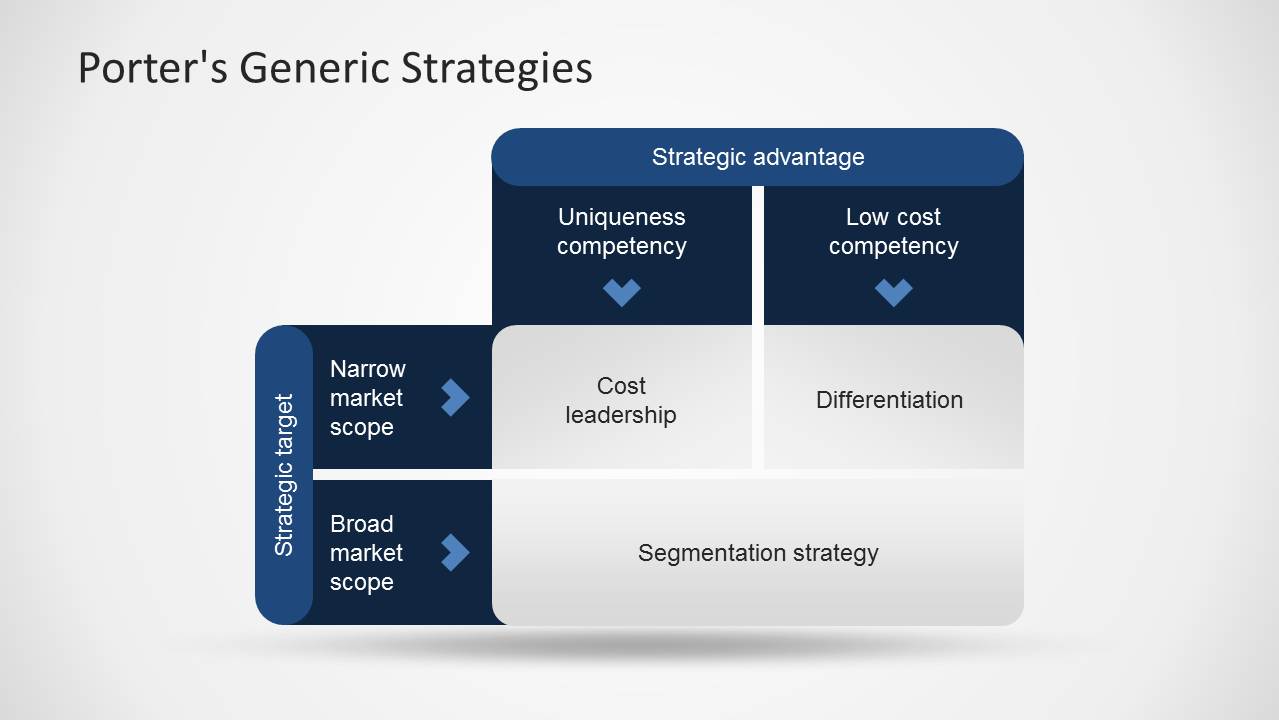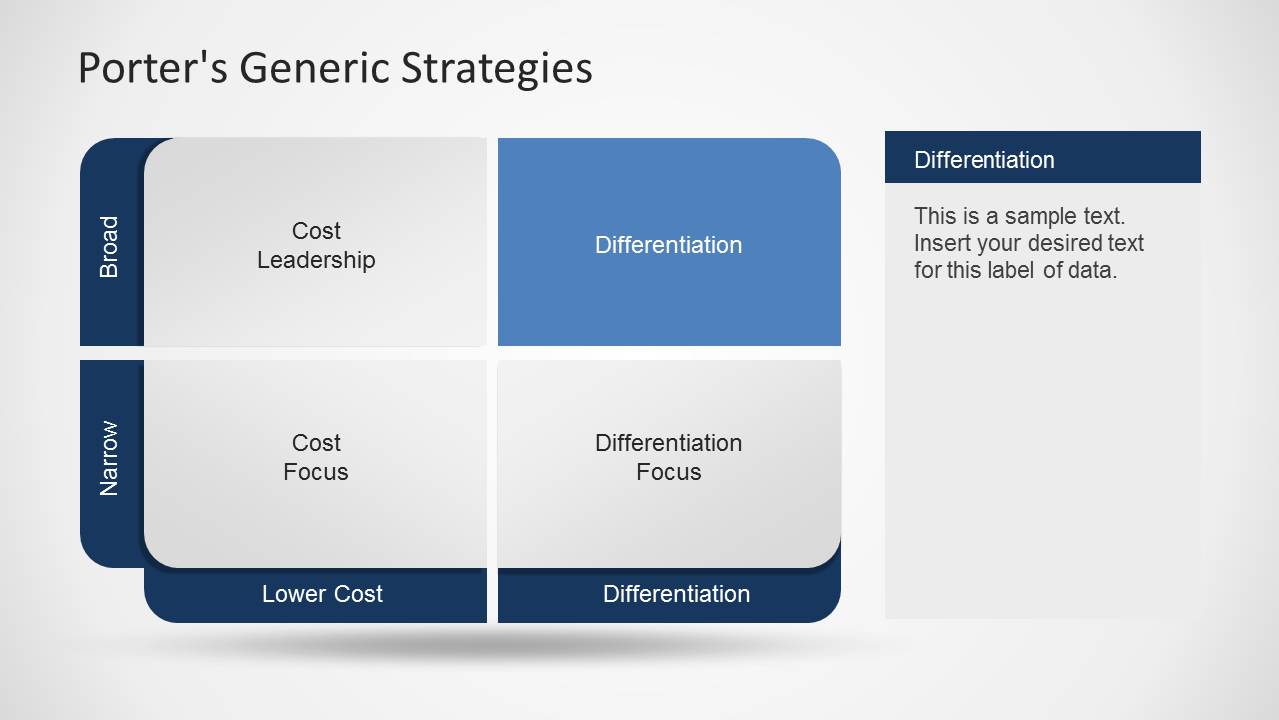Michael porter developed three generic competitive strategies, that can be used by a company for competitive advantage, back in 1980. According to michael porter, there are three fundamental ways in which firms might achieve sustainable competitive advantage.

Porter's Generic Strategy PowerPoint Template SlideModel
The focuser selects a segment or group of segments in the industry and tailors its strategy to serving them to the exclusion of others.
Michael porter 3 generic strategies. The generic strategies can be used to determine the direction (strategy) of your organisation. Cost focus and differentiation focus. these are shown in figure 1 below. The generic strategy of focus rests on the choice of a narrow competitive scope within an industry.
Cost leadership, differentiation, cost focus, and differentiation focus 1. According to magretta (2011, pp. Michael porter identified three basic strategies which cover the range of positions that a business can take to compete in the market.
They want it all, and consequently, they end up. Porter identifies three generic strategies for competitive advantage: There are three main streams for the michael porter’s generic strategies which are:
Joel greenblatt on value investing in 2022. 139), michael porter derived generic strategies from a well conventional theory that regarded profit and performance, firm strategy, and. According to porter, strategies allow organizations to gain competitive advantage from three different bases:
Their are some of the specific brands. What makes the company “strong” in the market. Michael porter uses 4 strategies that an organisation can choose from.
Michael porter is the founder and father of generic strategies. The focus strategy has two variants. Airlines are trying to be in all strategies simultaneously.
Porter’s generic strategies were developed in 1985 by michael porter, and they first appeared in his book “competitive advantage: A company chooses to pursue one of two types of competitive advantage, either via lower costs than its competition or by differentiating itself along dimensions valued by customers to command a higher price. Porter’s 5 forces • michael porter helps us answer the question:
Is this an attractive market for us to compete in?• once you pick an industry, the problem becomes: It is also about how and where management decides. The scope of the market targeted.
Porter, generic strategies framework, was introduced by michael porter in 1980. There are three/four generic strategies, either lower cost, differentiated, or focus. This chapter concentrates on establishing.
The competitive advantage of the company. It is in the context of the overall generic strategy which a firm may be pursuing that strategic I) cost leadership strategy, ii) differentiation strategy, and iii) focus strategy.
(a) in cost focus a firm seeks a cost advantage in its target. Probably the three most widely read books on competitive analysis in the 1980s were michael porter’s competitive strategy (1980), competitive advantage (1985), and competitive advantage of nations (1989). If the company is targeting the entire market or just a small.
• defensive strategies take the structure of the industry as given, and position the There are two more specific ways to achieve cost leadership according to. Michael porters generic strategies application example porters generic strategies companies example 1.
Porter’ s five forc es. The strategies proposed depend on: Porter’s generic strategies are the standard basic strategies that a business can follow, suggested by michael porter.
This article will go into porter’s generic strategies with the aid of examples. A company also chooses one of two types of scope, either focus (offer… How can we best compete for customers in this industry?
The model describes how companies can pursue a competitive advantage by choosing the right strategies. The four generic strategies of porter explained: The four strategies to choose from are:
Porter (1980, p.80) argues that “understanding the. He then subdivided the focus strategy into two parts: Companies can avail the competitive.
And understanding the five forces model and the generic strategies. Porter's generic strategies designed by michael porter in 1979, porter’s generic strategies is a frameworks used to outline the three major strategic options open to organizations that wish to achieve a sustainable competitive advantage. Creating and sustaining superior performance.” these strategies help businesses assess their growth, management, and profitability and create a competitive advantage.
He believes that a company must choose a clear course in order to be able to beat the competition. Porter's generic strategies describe how a company pursues competitive advantage across its chosen market scope. • in general, the strategy can be offensive or defensive with respect to competitive forces.
These main strategies are divided in 5 types: He discovered and launched them in 1980 leading to the age of generic strategies (schaede, 2008, pp. Each of the three options needs to be considered within the context of two aspects of the competitive environment.
A cost leadership strategy is an approach to building and maintaining a competitive advantage aimed at maximizing earning potential or profits. Porter called the generic strategies cost leadership (no frills), differentiation (creating uniquely desirable products and services) and focus (offering a specialized service in a niche market). ‘being stuck in the middle’.
Cost leadership, differentiation and focus.

Perspektif Orang Hubungan Internasional Michael Porter Differentiation
Porter Generic Strategies Competitive Advantage Strategic Management
Porter's generic strategies Download Scientific Diagram


